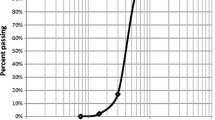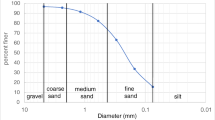Abstract
The processes of wind erosion of fertile soil, dune movement in sand deserts, dust storms in arid and semi-arid regions, as well as the emission and dispersion of agricultural or industrial dusts create a lot of problems and dangers for human life, environment, and infrastructure. Conventional ways to suppress dust emission to the atmosphere are agricultural fixation in the case of fertile soil surface and application of chemical agents to immobilize dust particulates onto the surface of soil, desert sand, country roads, or mining areas. However, these methods are often too expensive to be applied for large-scale suppression of sand dust. Chemical methods of dust suppression are often environmentally unfriendly due to the release of toxic reagents in water, air, and soil. This paper examines, for the first time, the microbially mediated aggregation of fine sand particles to suppress the emission of sand dust and its chemical and bacteriological pollutants. The bioaggregation reagent was a solution of calcium chloride and urea sprayed over the sand surface, which was preliminarily treated with the suspension of urease-producing bacteria. Quantity of calcium used for sand dust suppression was 15.6 g of Ca/m2. After the biotreatment of fine sand, the release of sand dust and its artificial pollutants to the atmosphere decreased in comparison with control by 99.8 % for dust, 92.7 % for phenantherene, 94.4 % for led nitrate, and 99.8 % for bacterial cells of Bacillus megaterium. This immobilization of dust and dust pollutants was due to the bioaggregation of fine sand particles. The sizes of 90 % of the sand dust particles increased from 29 μm in control to 181 μm after bioaggregation. Bioaggregation treatment of the soil surface could be a useful method to prevent the dispersion of dust and dust-associated chemical and bacteriological pollutants in water, air, and soil.




Similar content being viewed by others
References
Bagnold, R. A. (2005). The physics of blown sand and desert dunes. New York: Dover Publications. 320.
Bang, S., Min, S. H., & Bang, S. S. (2011). Application of microbiologically induced soil stabilization technique for dust suppression. International Journal of Geo-Engineering, 3, 27–37.
Boreson, J., Dillner, A. M., & Peccia, J. (2004). Correlating bioaerosol load with PM2.5 and PM10cf concentrations: a comparison between natural desert and urban-fringe aerosols. Atmospheric Environment, 38, 6029–6041.
Chu, J., Ivanov, V., Stabnikov, V., He, J., Li, B., & Naemi, M. (2012a). Biocement: green building- and energy-saving material. Advanced Materials Research, 347–353, 4051–4054.
Chu, J., Stabnikov, V., & Ivanov, V. (2012b). Microbially induced calcium carbonate precipitation on surface or in the bulk of soil. Geomicrobiology Journal, 29, 544–549.
Ci, L., & Yang, X. (2010). Desertification and its control in China (p. 500). China: Springer/Higher Education Press.
Copeland, C. R., Eisele, T. C., & Kawatra, S. K. (2009). Suppression of airborne particulates in iron ore processing facilities. International Journal of Mineral Processing, 93, 232–238.
Cordesman, A. H. (2002). Terrorism, asymmetric warfare, and weapons of mass destruction: Defending the U.S. homeland. Westport: Praeger Publishers.
DeJong, J. T., Mortensen, B. M., Martinez, B. C., & Nelson, D. C. (2010). Bio-mediated soil improvement. Ecological Engineering, 36, 197–210.
DeJong, J. T., Soga, K., Banwart, S. A., Whalley, W. R., Ginn, T. R., Nelson, D. C., et al. (2011). Soil engineering in vivo: harnessing natural biogeochemical systems for sustainable, multi-functional engineering solutions. Journal of the Royal Society, Interface, 8, 1–15.
DeJong, J. T., Soga, K., Kavazanjian, E., et al. (2013). Biogeochemical processes and geotechnical applications: progress, opportunities and challenges. Geotechnique, 63, 287–301.
Falkovich, A. H., Schkolnik, G., Ganor, E., & Rudich, Y. (2004). Adsorption of organic compounds pertinent to urban environments onto mineral dust particles. Journal of Geophysical Research, 109, D02208.
Funasaka, K., Sakai, M., Shinya, M., Miyazaki, T., Kamiura, T., Kaneco, S., et al. (2003). Size distributions and characteristics of atmospheric inorganic particles by regional comparative study in Urban Osaka, Japan. Atmospheric Environment, 37, 4597–4605.
Gargulak, J. D. & Lebo, S. E. (1999). Commercial use of lignin-based materials. In: Lignin: Historical, Biological, and Materials Perspectives, ACS Symposium Series, 742, 304–320.
Gat, D., Tsesarsky, M., & Shamir, D. (2011). Ureolytic CaCO3 precipitation in the presence of non-ureolytic competing bacteria. ASCE Geo-Frontiers 2011, Geotechnical Special Publication, 211, 3966–3964.
Goodrich, B. A., & Jacobi, W. R. (2012). Foliar damage, ion content, and mortality rate of five common roadside tree species treated with soil applications of magnesium chloride. Water, Air, and Soil Pollution, 223, 847–862.
Griffin, D. W., Kubilay, N., Koçak, M., Gray, M. A., Borden, T. C., & Shinn, E. A. (2007). Airborne desert dust and aeromicrobiology over the Turkish Mediterranean coastline. Atmospheric Environment, 1, 4050–4062.
Ichinose, T., Yoshida, S., Hiyoshi, K., Sadakane, K., Takano, H., Nishikawa, M., et al. (2008). The effects of microbial materials adhered to Asian sand dust on allergic lung inflammation. Archives of Environmental Contamination and Toxicology, 55, 348–357.
Ivanov, V. (2010). Environmental microbiology for engineers. CRC Press, pp. 402.
Ivanov, V., & Chu, J. (2008). Applications of microorganisms to geotechnical engineering for bioclogging and biocementation of soil in situ. Reviews in Environmental Science and Biotechnology, 7, 139–153.
Lee, H. N., Igarashi, Y., Chiba, M., Aoyama, M., Hirose, K., et al. (2006). Global model simulations of the transport of Asian and Sahara dust: total deposition of dust mass in Japan. Water, Air, and Soil Pollution, 169, 137–166.
Lee, S., Choi, B., Yi, S. M., & Ko, G. P. (2009). Characterization of microbial community during Asian dust events in Korea. Science of the Total Environment, 407, 5308–5314.
Mitchell, J. K., & Santamarina, J. C. (2005). Biological considerations in geotechnical engineering. Journal of Geotechnical and Geoenvironmental Engineering ASCE, 131, 1222–1233.
Naemi, S. A., & Ghorbanalizadeh, M. (2010). Effect of wet and dry conditions on strength of silty soil stabilized with epoxy resin polymer. Journal of Applied Sciences, 10, 2839–2846.
Nij, E. T., Hilhorst, S., Spee, T., Spierings, J., Steffens, F., Lumens, M., et al. (2003). Dust control measures in the construction industry. Annals of Occupational Hygiene, 47, 211–218.
Orts, W. J., Roa-Espinosa, A., Sojka, R. E., Glenn, G. M., Imam, S. H., Erlacher, K., et al. (2007). Use of synthetic polymers and biopolymers for soil stabilization in agricultural, construction, and military applications. Journal of Materials in Civil Engineering, 19, 58–66.
Parra, R. R., Medina, V. F., & Conca, J. L. (2009). The use of fixatives for response to a radiation dispersal devise attack – a review of the current (2009) state-of-the-art. Journal of Environmental Radioactivity, 100, 923–934.
Petry, T. M., & Little, D. N. (2002). Review of stabilization of clays and expansive soils in pavement and lightly loaded structures-history, practice and future. Journal of Materials in Civil Engineering, 14, 447–460.
Raisi, L., Lazaridis, M., & Katsivela, E. (2010). Relationship between airborne microbial and particulate matter concentrations in the ambient air at a Mediterranean site. Global NEST Journal, 12, 84–91.
Santoni, R. L., Tingle, J. S., & Nieves, M. (2005). Accelerated strength improvement of silty sand with nontraditional additives. Transportation Research Record: Journal of the Transportation Research Board, 1936, 34–42.
Stabnikov, V., Naemi, M., Ivanov, V., & Chu, J. (2011). Formation of water-impermeable crust on sand surface using biocement. Cement and Concrete Research, 41, 1143–1149.
Thompson, R. J., & Visser, A. T. (2007). Selection, performance and economic evaluation of dust palliatives on surface mine haul roads. Journal of South African Institute of Mining and Metallurgy, 107, 435–450.
US Army, US Air Force. (2005). Dust control for roads, airfields, and adjacent areas. Honolulu: University Press of the Pacific. 48.
van Paassen, L. A., Ghose, R., van der Linden, T. J. M., van der Star, W. R. L., & van Loosdrecht, M. C. M. (2010). Quantifying biomediated ground improvement by ureolysis: large-scale biogrout experiment. Journal of Geotechnical & Geoenvironmental Engineering ASCE, 136, 1721–1728.
Yang, K., & Tang, Z. (2012). Effectiveness of fly ash and polyacrylamide as a sand-fixing agent for wind erosion control. Water, Air, and Soil Pollution, 223, 4065–4074.
Yang, J., Cao, H., Wang, F., & Tan, T. (2007). Application and appreciation of chemical sand fixing (aspartic acid) and its composites. Environmental Pollution, 150, 381–384.
Zandieh, A. R., & Yasrobi, S. S. (2010). Study of factors affecting the compressive strength of sandy soil stabilized with polymer. Geotechnical and Geological Engineering, 28, 139–145.
Zhang, W., Zhuang, G., Huang, K., Li, J., Zhang, R., Wang, Q., et al. (2010). Mixing and transformation of Asian dust with pollution in the two dust storms over the northern China in 2006. Atmospheric Environment, 44, 3394–3403.
Acknowledgments
This research was supported in part by the grant from the Agency for Science, Technology and Research (A*STAR), Singapore.
Author information
Authors and Affiliations
Corresponding author
Additional information
Volodymyr Ivanov and Jian Chu are formerly associated with Nanyang Technological University, Singapore.
Rights and permissions
About this article
Cite this article
Stabnikov, V., Chu, J., Myo, A.N. et al. Immobilization of Sand Dust and Associated Pollutants Using Bioaggregation. Water Air Soil Pollut 224, 1631 (2013). https://doi.org/10.1007/s11270-013-1631-0
Received:
Accepted:
Published:
DOI: https://doi.org/10.1007/s11270-013-1631-0




